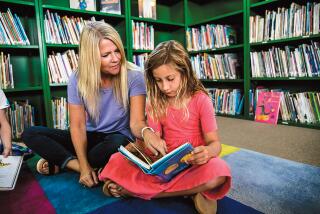READING TIPS AND NOTES
- Share via
Think for a moment about how you decided to read this column today. Perhaps you were paging through the paper and the topic caught your eye. Or maybe you’re a parent and have a young reader at home. Or possibly you’re an educator.
As the author, I have a particular purpose in writing this article, whether or not it matches your reason for reading it. Ultimately, your comprehension of what I have written depends on a number of critical factors, including your purpose and your knowledge of the topic.
The process of comprehension is a fascinating one. In the past, we thought this was a relatively simple means of converting symbols into meaning. Now we know that comprehension is complex.
From research, we have learned that effective readers use a variety of strategies to make sense of what they read. The meaning you construct from reading this column will depend in part on what you bring to it from your own background. The same holds true for any topic you’re reading about.
For example, if I know something about tide pools in Southern California, I can use this knowledge to help me understand a magazine article on marine life. I can connect what I’ve personally experienced while exploring a tide pool, what I’ve seen in a movie, what I’ve previously read about to what I’m currently reading. Generally speaking, the more you know about a topic, the better you comprehend when you read something about it.
As another example, consider the sentence, “When the seam split, the old bag collapsed.” What does this mean to you? Is the seam on a dress? A pair of pants? Is the “old bag” a derogatory term for an older person? For an instrument used for cake decorating? For something that is attached to a vacuum cleaner? You bagpipers out there may have had no difficulty creating a meaning for this sentence, but the rest of you probably struggled with its ambiguity. See what I mean about the connection between what we know and what we are reading?
How does this relate, then, to helping children become effective readers? First, teachers and parents can ask children to talk about what they already know about a topic prior to reading. Guide them to look at book covers, glance through pictures (a “picture walk”), and talk about experiences they have had that relate to the topic.
Second, while reading together, help children make connections to their own lives, to common experiences that all people share, and to other books or stories that have similar ideas or plots.
Third, point out incidents in the story or article that may be familiar and try to build background for those that are new.
Fourth, encourage children to talk about their own interpretations of a story or article, even when they may differ from the obvious or from yours. Asking questions like, “What made you think that?” or “Where did you get that idea?” helps children see it is important to make connections between what they know and what they are reading about.
Last, share your thoughts and the connections you’re making as you and your child read together. When experienced readers talk about how they think during the reading process, they are providing an important model for the emergent reader.
BOOK EVENTS
* Tuesday in Ventura: Storytime and crafts for children at 10:30 a.m., at Adventures for Kids bookstore, 3457 Telegraph Road. (805) 650-9688.
* Wednesday in Harbor City: Suni Paz, a bilingual storyteller, will perform and sing songs in English and Spanish at 3:30 at the Harbor Gateway-Harbor City Library, 1555 W. Sepulveda Blvd. (310) 548-7791
* Friday in Valencia: Gypsy Folk Ensemble will perform renaissance dances for children at 4 p.m. at the Valencia Public Library, 23743 Valencia Blvd. Call to sign up for this free event at (661) 259-8942.
* Saturday in Pasadena: Storytime at 10 a.m. at Vroman’s Bookstore, 695 E. Colorado Blvd. (626) 449-5320.


